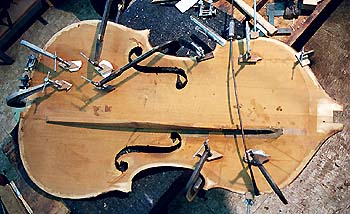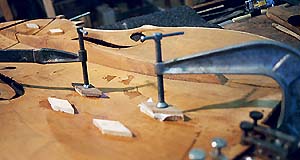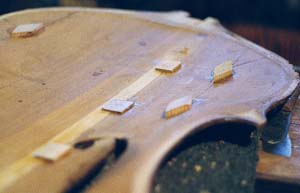![]()
|
|
|
|
Face clamps hold the loose piece of top in place while I hide glue it. I install as many of the patches (also called cleats) for the cracks as I can each gluing, limited by room and number of clamps. The location of each cleat is carefully planned. Freezer or wax paper is put between the patches and the clamp pressure pads to keep from gluing the pads to the top. |
 |
|
There is a crack going directly under the old bass bar. Our new bar is going in the same place so I will have to inlay some cleats under the bar. There is a similar crack on the top end requiring the same repair. |
|
Using diamond shaped spruce cleats put the most added mass under the crack. More cleats can be put closer together with this shape (when necessary). I make the cleats with the grain at 45 degrees instead of the more typical 90 degrees. All this serves to keep the top flexible yet strong. |
|
|
More cleats are glued on. Before the top is put back on the patches will be "feathered", their edges carved down to nothing. This makes them more flexible and less likely to come loose, causing a rattle or buzz. |
 |
|
|
To inlay the cleats under the bar I measure the top thickness there and remove a little less than half with a router. I then use sharp chisels to square the edges and fit the cleat. For inlaid cleats I prefer to use rectangular shaped spruce with the grain at 45 degrees. The cleat is glued in and carved down. |
|
|
 |
|
With the top cracks patched and the inlay cleats carved down, I can now fit the new bass bar. |
copyright 2000 William E. Merchant, all rights reserved